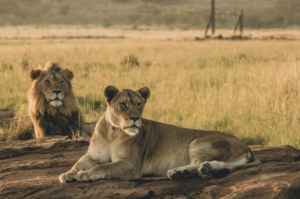In today’s rapidly changing world, understanding the movements and behaviors of wildlife has never been more crucial. From conservation efforts to scientific research, the ability to track and monitor animals has revolutionized our understanding of the animal kingdom. One technology that has played a pivotal role in this transformation is GPS wildlife tracking. In this article, we will explore wildlife GPS tracker and its significant contributions to the field of wildlife biology and conservation.
The Evolution of Wildlife Tracking
Before the advent of GPS technology, tracking wildlife was a labor-intensive and often imprecise endeavor. Researchers relied on traditional methods such as radio telemetry, which involved attaching radio transmitters to animals and then using specialized equipment to locate them. While this approach provided valuable data, it had limitations, including range constraints and the need for frequent equipment retrieval.
The Arrival of GPS Tracking
The introduction of Global Positioning System (GPS) technology marked a pivotal moment in wildlife tracking. GPS tracking devices, equipped with miniature GPS receivers, began replacing traditional radio transmitters. This transition allowed researchers to monitor animal movements with unprecedented accuracy and efficiency. Here’s how GPS wildlife tracking works:
- GPS Satellites: A constellation of GPS satellites orbits the Earth, constantly emitting signals that contain precise timing and location data;
- GPS Tracking Device: The animal is fitted with a GPS tracking device, typically in the form of a collar, tag, or implanted microchip. This device receives signals from multiple GPS satellites;
- Data Collection: The tracking device collects GPS signals and calculates the animal’s precise location, including latitude and longitude;
- Data Transmission: Some GPS devices can transmit data in real time via satellite or cellular networks, while others store the data for later retrieval;
- Analysis: Researchers can access the collected data to analyze the animal’s movements, behavior, and habitat use.
Tracking Wildlife in Real Time: Project ICARUS Takes Flight
Project ICARUS (International Cooperation for Animal Research Using Space), led by Dr. Wikelski at the Max Planck Institute for Animal Behavior, is pioneering a groundbreaking transformation in animal tracking through an interactive platform known as the “Internet of Animals.” This platform is poised to enable individuals from all corners of the globe to monitor tracker animals in near-real time.
As the GIS and technical computing associate at the Center for Conservation Innovation (CCI) within Defenders, the captivating celestial development led to reflections on how much simpler life would have been during the tenure as a field technician, tracking seabirds in locations like Alaska and Connecticut. All too often, these birds would return to their nests without the GPS trackers meticulously deployed days prior. The absence of these animal trackers left the team in the dark regarding the distance these birds traveled for sustenance and which regions provided an ample supply of fish, especially as changing sea surface temperatures altered their habitat. In other instances, the tagged birds could only be tracked within a limited range of a few miles from the antenna, necessitating boat expeditions, complete with the antenna, to locate them.
This new technology holds the potential to alleviate many of the heartaches, mishaps, and obstacles that often accompany the tracking tools used by wildlife biologists. Furthermore, the global species data collected by ICARUS could propel the work of Defenders forward by significant margins. It promises to deepen comprehension of animal movements across North America and the entire world, all without requiring a departure from headquarters in Washington, DC.
Advancements in Contemporary Wildlife Tracking Techniques

In the realm of modern wildlife tracking, two predominant technologies have come to the forefront:
- GPS Tracking: This method involves the utilization of GPS tracking devices, such as tags on seabirds or collars on bobcats, to receive signals from Earth-orbiting satellites. These signals pinpoint the precise location of the GPS tracker. The data collected is stored within the tracker and can be retrieved remotely, or in some cases, the tracker must be physically retrieved from the animal. Unfortunately, if the tracker is lost, as we experienced numerous times in Alaska, not only is the expensive equipment forfeited, but the valuable data is also lost;
- Radio Telemetry: One prevalent form of radio telemetry is “Very High Frequency” (VHF) radio tracking. Similar to GPS devices, radio transmitters are affixed to animals to track their movements. Researchers employ antennas to detect transmissions from the animal’s device, provided it is within range.
Despite the advantages of collecting spatial data on animal movements through these technologies, there are several limitations to consider:
- Attaching and retrieving trackers can be stressful for animals, often necessitating recapture;
- Some trackers have limited battery life, providing only a brief snapshot of the animal’s movements;
- Radio transmitters are constrained by the distance an animal travels from the antenna, posing challenges for species with extensive migration routes;
- The use of radio telemetry can result in substantial cell phone bills, especially when data is transmitted as SMS messages, as exemplified by the Russian eagles’ costly data roaming charges when they left the country.
While there are innovative solutions to address these challenges, such as solar-powered GPS trackers that enable remote data sharing and the creative approach of Cornell Lab of Ornithology’s “VultureNet,” which uses turkey vultures as data collectors, many of these solutions remain expensive, lack global coverage, and primarily focus on tracking location rather than additional factors like an animal’s health or the surrounding environment.
ICARUS: Revolutionizing Wildlife Tracking
Enter ICARUS and its groundbreaking solution, the “Internet of Animals,” poised to revolutionize wildlife tracking as we know it! This pioneering project introduces specially designed tags that combine radio transmitters and GPS technology, offering remarkable advantages. These tags are exceptionally compact and lightweight, opening up the possibility of tracking even the tiniest of species that were previously beyond reach. What sets these tags apart is their multifunctionality, equipped with an accelerometer (measuring velocity), magnetometer (detecting shifts in magnetic fields), gyroscope (assessing orientation and rotation), and temperature sensor. As a result, ICARUS not only monitors the geographic location of animals but also delves into their physiology, including skin temperature and body position, along with real-time environmental weather data. This comprehensive approach provides invaluable insights into the well-being of animals and their surroundings.
Unlike traditional tracking methods that rely on mobile networks for data transmission via costly SMS messages, ICARUS takes a revolutionary leap forward. Its transmitters operate on a dedicated system that communicates exclusively with the newly installed satellite on the space station. This centralized system offers cost-effective worldwide data collection and access.
Dr. Wikelski and his team are committed to making the data accessible in real time to a broad audience, including scientists, policy makers, and the general public, through the Movebank database and a user-friendly mobile application. This real-time data has diverse applications, from tracking threatened or endangered species to combatting poaching. The platform can notify researchers when a tagged animal stops moving or experiences a significant drop in body temperature, enhancing conservation efforts. Remarkably, these trackers can endure an animal’s entire lifetime without the need for retrieval, streamlining the monitoring process and advancing our understanding of wildlife in unprecedented ways.
The Crucial Role of Wildlife Tracking in a Dynamic World
While each approach employs slightly different techniques, the ultimate goal remains consistent: the acquisition of geospatial data to reveal the whereabouts of wildlife. Armed with this invaluable information, the dedicated geospatial team at CCI can precisely identify the habitats upon which these species depend for sustenance, shelter, mating, and migration. This knowledge, in turn, enhances the comprehension of habitat connectivity requirements for various species, particularly as they navigate changing climatic conditions or respond to habitat degradation.
The realization of Dr. Wikelski’s 19-year dream through the ICARUS project, in the form of comprehensive wildlife traffic network data, carries the potential to revolutionize wildlife research on a global scale. These data could enable us to monitor alterations in the migration patterns of vulnerable species influenced by climate change. They could also offer insights into the precise routes animals take when dispersing across the U.S.-Mexico border, aiding in the prioritization of conservation efforts, especially in the face of extensive border barrier construction. Furthermore, we could gain a deeper understanding of disease patterns among wildlife near urban areas, allowing us to proactively address the threat of pandemics like the one we currently face. Dr. Wikelski even suggests that this data might be used to identify unusual wildlife movements in real time, potentially serving as indicators of natural events that animals can sense, such as earthquakes, volcanic eruptions, and tsunamis.
On a more localized scale, this technology could be utilized to track the movements of creatures as close as the bobcat in backyard or the hummingbird embarking on a 500-mile journey across the Gulf of Mexico. Whether it’s enlightening amateur naturalists or aiding seasoned scientists, the “Internet of Animals” holds the potential to reinvigorate and enrich wildlife conservation efforts on a global scale.
Applications of GPS Wildlife Tracking

GPS wildlife tracking has a wide range of applications in wildlife research and conservation:
| Purpose | Description |
|---|---|
| Migration Studies | Tracking migratory patterns of birds, mammals, and marine species helps researchers understand their navigation and habitat preferences. |
| Conservation Efforts | GPS data informs conservation strategies, such as identifying critical habitats, monitoring the spread of invasive species, and mitigating human-wildlife conflicts. |
| Behavioral Research | Researchers can study animal behavior, including foraging habits, territory size, and social interactions. |
| Climate Change Studies | GPS tracking helps assess how wildlife responds to changing environmental conditions, such as shifts in temperature or habitat availability. |
- Migration Studies: One of the primary applications involves tracking the intricate migratory patterns of birds, mammals, and marine species. This knowledge helps researchers gain profound insights into how these animals navigate vast distances and select specific habitats along their migratory routes. By understanding their migratory behaviors, scientists can address critical questions related to breeding, feeding, and survival;
- Conservation Efforts: GPS data plays a pivotal role in the conservation of endangered and threatened species. It aids conservationists in identifying and preserving critical habitats, which are essential for the survival of various wildlife populations. Additionally, GPS technology is instrumental in monitoring and managing the spread of invasive species, which can wreak havoc on native ecosystems. Furthermore, it assists in mitigating human-wildlife conflicts by providing data on animal movements that can inform strategies to reduce conflicts and promote coexistence;
- Behavioral Research: GPS wildlife tracking enables researchers to delve into the fascinating world of animal behavior. Scientists can study a wide range of behaviors, including foraging habits, territory size, social interactions, and even mating rituals. This detailed understanding of animal behavior contributes to a deeper comprehension of ecological relationships and the role of specific behaviors in species survival;
- Climate Change Studies: As our planet undergoes rapid environmental changes due to climate change, GPS tracking serves as an invaluable tool to assess how wildlife adapts and responds. By monitoring animal movements, scientists can gauge how wildlife populations adjust to shifts in temperature, habitat availability, and resource distribution. This information is crucial for predicting the impact of climate change on wildlife and developing strategies for their conservation in an ever-changing world.
Conclusion
In conclusion, the evolution of GPS wildlife tracking has truly revolutionized the understanding of the animal kingdom. This remarkable technology, with its precision and non-invasiveness, has allowed us to unlock the secrets of animal movements like never before. Whether it’s studying the migratory patterns of birds, monitoring critical habitats for conservation, or delving into the intricacies of animal behavior, wild animal trackers have become indispensable tools in the realm of wildlife research and conservation. As we navigate an ever-changing world, the ability to track and monitor wildlife through GPS technology continues to play a pivotal role in efforts to protect and preserve the diverse species that share our planet.













+ There are no comments
Add yours